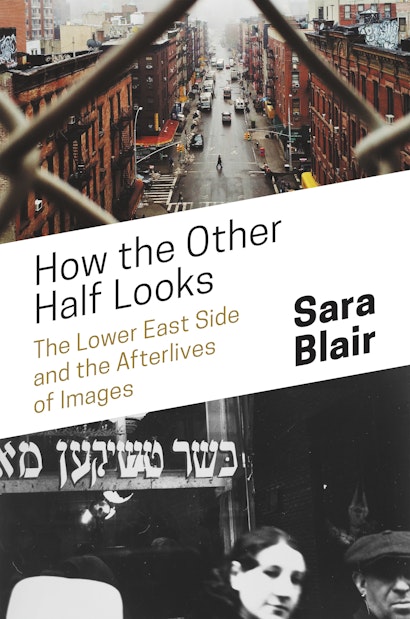New York City’s Lower East Side, long viewed as the space of what Jacob Riis notoriously called the “other half,” was also a crucible for experimentation in photography, film, literature, and visual technologies. This book takes an unprecedented look at the practices of observation that emerged from this critical site of encounter, showing how they have informed literary and everyday narratives of America, its citizens, and its possible futures.
Taking readers from the mid-nineteenth century to the present, Sara Blair traces the career of the Lower East Side as a place where image-makers, writers, and social reformers tested new techniques for apprehending America—and their subjects looked back, confronting the means used to represent them. This dynamic shaped the birth of American photojournalism, the writings of Stephen Crane and Abraham Cahan, and the forms of early cinema. During the 1930s, the emptying ghetto opened contested views of the modern city, animating the work of such writers and photographers as Henry Roth, Walker Evans, and Ben Shahn. After World War II, the Lower East Side became a key resource for imagining poetic revolution, as in the work of Allen Ginsberg and LeRoi Jones, and exploring dystopian futures, from Cold War atomic strikes to the death of print culture and the threat of climate change.
How the Other Half Looks reveals how the Lower East Side has inspired new ways of looking—and looking back—that have shaped literary and popular expression as well as American modernity.
Awards and Recognition
- Honorable Mention for the James Russell Lowell Prize, Modern Language Association
- Shortlisted for the MSA Book Prize, Modern Studies Association
"A fascinating visual history."—Bryan Cheyette, Times Literary Supplement
"How the Other Half Looks presents a remarkably broad, yet also detailed, look at the iconic works that have shaped how scholars and city dwellers alike understand and encounter urban spaces in the Lower East Side and beyond."—Aaron Shkuda, Gotham Center for New York City History blog
"It is an excellent choice for academic libraries supporting programs in the humanities and social sciences."—Barbara M. Bibel, Association of Jewish Library Reviews
"[An] excellent, highly original study…[How the Other Half Looks] also may be appreciated for its potential to stimulate scholars to probe how the immigrant and 'Jewish' quarters of cities may be approached as extraordinarily fertile sites for cultural history."—Michael Berkowitz, American Literary History
"Sara Blair deftly blends visual and aural evidence in this multilayered, multisensory journey through the Lower East Side and across several centuries. Blair draws our attention to how creative writers, journalists, photographers, poets, and so many others focused on what they think they saw and heard in that very special, indeed iconic slum."—Hasia R. Diner, author of Lower East Side Memories: A Jewish Place in America
"The twentieth century saw an explosion of photographic images, and arguably the Lower East Side was its ground zero. Sara Blair spins a virtuoso tale of the effect of this explosion on the creation and perception of place, from its social-cultural roots in anxieties of nineteenth-century immigration and urbanization to its furthest reaches in imagery of nuclear disaster and climate change."—Margaret Olin, author of Touching Photographs
"Illuminating at almost every turn, with a telling analytical expressiveness, an utterly persuasive narrative arc, and a tour-de-force impact. No work of art has made it more richly possible to see the usable pasts of the Lower East Side than Blair's book."—Thomas J. Ferraro, author of Feeling Italian: The Art of Ethnicity in America
"This is an ambitious, erudite, and richly layered book, one that provides both panoramic breadth and rigorous in-depth analysis. With beautiful prose and great narrative force, Blair shows how the Lower East Side became an experimental space in which new techniques of visualizing and narrating modern America were not only tested but also generated."—Catherine Rottenberg, editor of Black Harlem and the Jewish Lower East Side
"In this remarkable book, Sara Blair takes us through subtle and alert readings of Jacob Riis, D. W. Griffith, Paul Strand, Henry Roth, Ben Shahn, Allen Ginsberg, and Gary Shteyngart, among others. Exceptionally alert to historical and stylistic differences, to the sense that the Lower East Side itself is always changing and always the same, she constantly returns to the question of time: time lived and time recorded, time as an element in the development of our media and our perceptions."—Michael Wood, author of On Empson


